
League of Communists of Croatia was the Croatian branch of the League of Communists of Yugoslavia (SKJ). It came into power in 1945. Until 1952, it was known as Communist Party of Croatia. In the early 1990s, it underwent several renames and lost power.
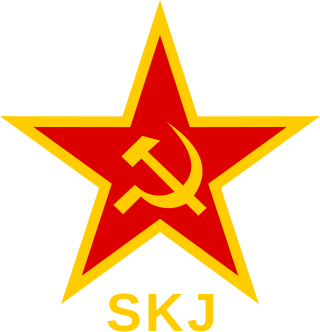
The League of Communists of Yugoslavia, known until 1952 as the Communist Party of Yugoslavia, was the founding and ruling party of SFR Yugoslavia. It was formed in 1919 as the main communist opposition party in the Kingdom of Serbs, Croats and Slovenes and after its initial successes in the elections, it was proscribed by the royal government and was at times harshly and violently suppressed. It remained an illegal underground group until World War II when, after the invasion of Yugoslavia in 1941, the military arm of the party, the Yugoslav Partisans, became embroiled in a bloody civil war and defeated the Axis powers and their local auxiliaries. After the liberation from foreign occupation in 1945, the party consolidated its power and established a one-party state, which existed in that form of government until 1990, two years prior to the breakup of Yugoslavia.

The Football Association of Yugoslavia (FSJ) was the governing body of football in Yugoslavia, based in Belgrade, with a major administrative branch in Zagreb.
The New Communist Party of Yugoslavia is an anti-revisionist Marxist–Leninist communist party in Serbia. Its goal is the reunification of Yugoslavia as a communist state according to Marxism–Leninism.
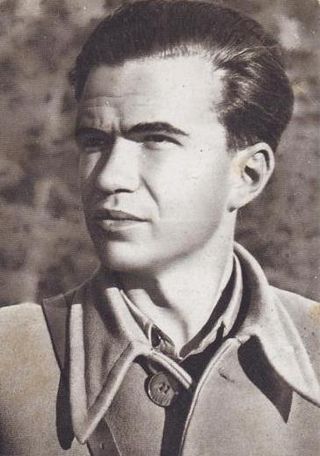
Ivan Ribar, known as Ivo Lola or Ivo Lolo, was a Yugoslav communist politician and military leader of Croatian descent. In the 1930s, he became one of the closest associates of Josip Broz Tito, leader of the Yugoslav Communist Party. In 1936, Ribar became secretary of the Central Committee of SKOJ. During World War II in Yugoslavia, Ribar was among the main leaders of the Yugoslav Partisans and was a member of the Partisan Supreme Headquarters. During the war, he founded and ran several leftist youth magazines. In 1942, Ribar was among the founders of the Unified League of Anti-Fascist Youth of Yugoslavia (USAOJ). He was killed by a German bomb in 1943 near Glamoč while boarding an airplane for Cairo, where he was to become the first representative of Communist Yugoslavia to the Middle East Command.
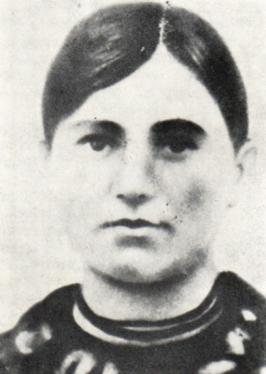
Marija Bursać was a member of the Yugoslav Partisans during World War II in Yugoslavia and the first woman proclaimed a People's Hero of Yugoslavia. Bursać was born to a Bosnian Serb farming family in the village of Kamenica, near Drvar. After the invasion of Yugoslavia by the Axis powers and their creation of the Independent State of Croatia in April 1941, Bursać supported the Partisan resistance movement led by the Communist Party of Yugoslavia (KPJ). Like other women in her village, she collected food, clothing, and other supplies for the Partisan war effort. Bursać became a member of the League of Communist Youth of Yugoslavia in September 1941. The following August she was appointed political commissar of a company of the 1st Krajina Agricultural Shock Brigade, which harvested crops in the Sanica River valley, and was admitted to the KPJ at the end of that summer.
The Socialist Youth League of Yugoslavia was a youth organization in Yugoslavia, the youth wing of the Socialist Party of Yugoslavia. It was founded by the students circle in Zagreb in 1921. As of the late 1920s, the claimed to have around 1,500 members.

Maja Bošković-Stulli was a Croatian slavicist and folklorist, literary historian, writer, publisher and an academic, noted for her extensive research of Croatian oral literature.
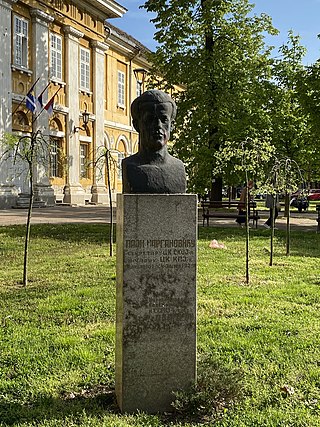
Pavle "Paja" Marganović was a Serbian communist activist and one of the Seven secretaries of SKOJ.
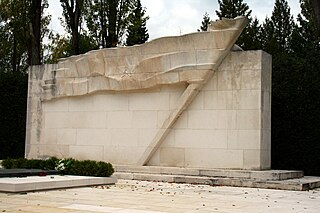
The Tomb of the People's Heroes is located in Zagreb's central graveyard, Mirogoj. It was designed by the Croatian sculptor Đuro Kavurić and built in 1968. Buried in the tomb are not only the recipients of the Order of the People's Hero, but also some of the most notable workers' movement activists of Croatia and Yugoslavia.
Vladimir Majder (1911–1943) was a Croatian Partisan who fought in the Spanish Civil War and World War II.

Aleksandar Savić was a Croatian communist activist and member of the partisan resistance movement in Croatia, murdered during the Holocaust in the Independent State of Croatia.

Viktor Rosenzweig (1914–1941) was a Croatian-Jewish communist, poet and writer.
The League of Socialist Youth of Bosnia and Herzegovina was a youth organization in the Socialist Republic of Bosnia and Herzegovina. SSOBiH traced its roots to the youth resistance movements during World War II, and became the main youth organization in the republic during the Tito era. During the 1980s, SSOBiH became increasingly autonomous from the party line and eventually became a political party of its own. It was succeeded by the Liberal Democratic Party.
The 1st Split Partisan Detachment or the 1st Split Detachment was a short-lived unit of the Yugoslav Partisans during World War II. It was composed of volunteers from the city of Split and was created in August 1941, just four months after the Axis occupation of Yugoslavia, and the annexation of Split and most of Dalmatia by the Kingdom of Italy. The unit, composed mostly of young men with little or no fighting experience, planned to relocate to the Dinara mountains to join other Partisan units in fighting the Axis powers.

Nikola "Niko" Hećimović, also Nicholas Hećimovića was a Croatian communist organizer and secretary of the Yugoslav branch of International Red Aid.

Ratomir "Rato" Dugonjić was a Yugoslav Partisan fighter in the antifascist liberation struggle of the people of Yugoslavia, Minister in the Communist Government, Ambassador with the Non-Aligned Movement, president of the Socialist Republic of Bosnia and Herzegovina and the Vice president of the Socialist Federal Republic of Yugoslavia. Dugonjić was a member of the Politburo Central Committee, League of Communists of Bosnia and Herzegovina and a member of the Central Committee of the League of Communists of Yugoslavia of the Fifth to Eighth Congress and member of the Presidium of the Central Committee. He was a member of the Presidency of Yugoslavia and Federation Council.
The Provincial Committee for Serbia or Provincial Committee of Serbia, abbreviated PKS/ПКС, was the branch of the Communist Party of Yugoslavia (KPJ) active in Serbia during the Kingdom of Yugoslavia and German-occupied Serbia during World War II. It was transformed into the Communist Party of Serbia in 8 May 1945.

The Communist Party of Yugoslavia held its 6th Congress in Zagreb on 2–7 November 1952. It was attended by 2,022 delegates representing 779,382 party members. The 6th Congress sought to discuss new policies, first of all in reaction to the Yugoslav–Soviet split and Yugoslav rapprochement with the United States. The congress is considered the peak of liberalisation of Yugoslav political life in the 1950s. The Congress also renamed the party the League of Communists of Yugoslavia.
The Socialist Republic of Croatia, one of the constituent countries of the Socialist Federal Republic of Yugoslavia had gone through a number of phases in its political life, during which its major political characteristics changed - its name, its top level leadership and ultimately its political organization.














